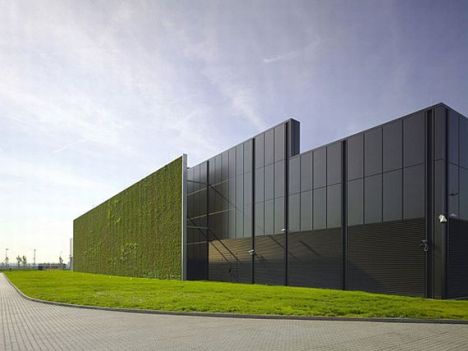
Citigroups’s Data Centre in Frankfurt, Germany. It has been awarded the LEED Platinum rating, the highest possible rating in the LEED program. LEED stands for Leadership in Energy and Environmental Design, a green building rating system developed by the U.S. Green Building Council (USGBC).
In recent years, Malaysia has been inching towards a greener mindset. There is now a much greater sense of environmental awareness than ever before in the country, though I must admit that it is still at a very humble level if compared to countries like Denmark, Germany, or Japan. In any case, there has been progress over the years and recently the hype is about green buildings. Inspired by green building rating tools such as UK’s BREEAM, USA’s LEED, Japan’s CASBEE, Australia’s GREENSTAR, and Singapore’s GREEN MARK, to name a few, Malaysia introduced its very own Green Building Index (GBI) in early 2009. GBI was jointly developed by the Malaysian Institute of Architects (PAM) and the Association of Consulting Engineers Malaysia (ACEM).
One may question the necessity for so many different standards, but according to the official GBI website:
Green rating tools by its nature and role is very dependent upon location and environment and thus climate… Malaysia’s Green Building Index or GBI will be the only rating tool for the tropical zones other than Singapore Government’s GREEN MARK.
So in other words, Malaysia’s GBI is customized to suit local conditions – our climate, current state of development, and existing resources. The GBI rating is based on six key criteria (generally based on the LEED certification of USA):
- Energy Efficiency
- Indoor Environmental Quality
- Sustainable Site Planning and Management
- Materials and Resources
- Water Efficiency
- Innovation
A good example demonstrating the characteristics of a green building is the David Brower Center in Berkeley, California. The Center’s design includes:
- Construction using 53% recycled materials;
- Photovoltaic panels which will double as a sun shade device;
- 100% daylighting of all office areas;
- Collection and reuse of rainwater for irrigation and toilet flushing;
- Extremely low energy mechanical systems using radiant heating and cooling within the building’s concrete structural slabs;
- Solar shading devices on all south-facing windows;
- High efficiency lighting with automatic controls to limit use when adequate daylight is available;
- Concrete with slag to significantly reduce CO2 and cement content, and to increase strength;
- Vertically post-tensioned structure to minimize potential damage due to earthquakes;
- Operable windows and low pressure ventilation via the raised floor system to maximize indoor air quality;
- CO2 sensors that call for extra fresh air if required; and
- Exterior and interior materials that ensure healthy air quality, maximize recycled content, avoid off-gassing, and minimize environmental impacts from production and transportation.
The David Brower Center is expected to attain the LEED Platinum rating, the highest possible rating from the LEED program. As one can see from the above list of characteristics, many factors are taken into consideration right from the early design and planning stages of building a green building. Like the materials used for construction, the placing of photovoltaic panels for optimal exposure to sunlight, the positioning of windows and openings for day-lighting and natural ventilation, and the rainwater collection and reuse system.
With reference to item #8 in the above list of sustainable characteristics of the David Brower Center; slag is a by-product formed as a result of smelting, welding and other metallurgical and combustion processes involving metals or ores. Its use as a construction material in buildings not only diverts it from the landfill, it reduces the use of cement which in turn reduces the energy and resources required to manufacture cement. Fly ash, a by-product from coal-fired power plants, is also similarly used as a supplementary cementitious material. Both slag and fly ash not only helps in reducing the use of cement and its associated environmental impacts from manufacturing, they also make the concrete stronger, more durable, and more resistant to chemical attack than when it is constructed with cement alone.
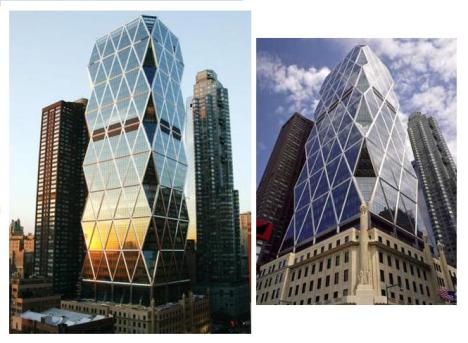
Hearst Tower, New York
Aside from the David Brower Center, there is a long list of other green buildings with very innovative sustainable designs and functions. One other building significant to note is the Hearst Tower in New York that has a LEED Gold rating. Aside from its energy/water efficiency features and recyclable content used in its construction, what makes this building stand out is the use of the diagrid system (diagonal + grid). It is a system which uses a series of triangles to support the building which eliminates the need for vertical steel beams altogether. The diagrid system not only provides stronger support due to the force-distributing nature of the triangular framework, it also required 20% less steel in the construction of the Hearst Tower. That is a good 2,000 ton savings in steel.
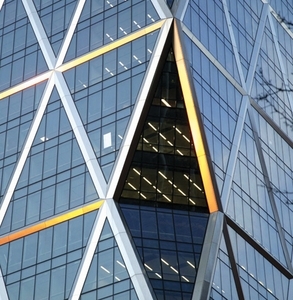
The diagrid system used for the Hearst Tower
There are many more awesome green buildings out there to be discovered and even more hardcore ones to come in the near future. So far, Malaysia has only a handful of green buildings. Examples include:
1. Mesiniaga Tower in Subang Jaya, Selangor (1993)
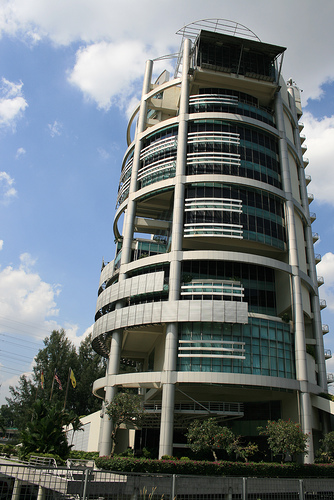
Mesiniaga Tower, Subang Jaya, Selangor
2. Securities Commision building in Bukit Kiara, Kuala Lumpur (1999)
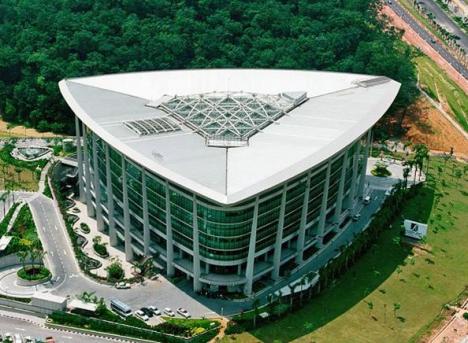
Securities Commission, Kuala Lumpur
3. Low Energy Office (LEO) building in Putrajaya, Kuala Lumpur (2004)
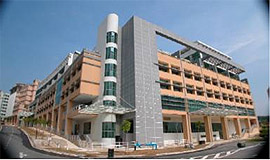
Low Energy Office (LEO) building, Putrajaya
4. Zero Energy Office (ZEO) building in Bandar Baru Bangi, Selangor (2007)
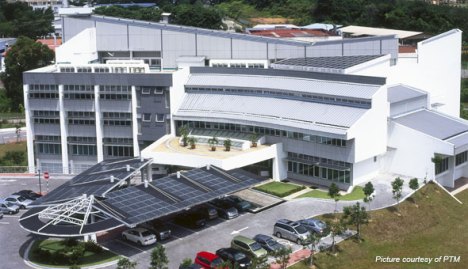
Zero Energy Office (ZEO) building, Bandar Baru Bangi, Selangor
Although the above-listed Malaysian buildings may not be as impressive as those abroad, they are definitely significant milestones for the development of green buildings in the country. Now with our very own green building certification, the GBI, equipped with specific guidelines and criteria for certification, it will not be long before we see the construction of green buildings that are on par with (if not better than) those abroad. Malaysia’s newest green building, named the Diamond building, is already under construction in Putrajaya, Kuala Lumpur. The Diamond building has a GREEN MARK Platinum rating from Singapore.
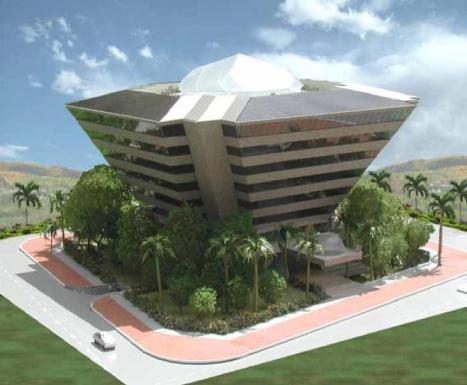
Model of the to-be completed Diamond building in Putrajaya.
The Malaysian government is also very supportive of the development of green buildings in the country. In fact, recently it has been decided that all new government buildings must incorporate the features of GBI. Aside from that, in the recent tabling of Malaysia’s Budget 2010, Prime Minister Datuk Seri Najib Tun Razak announced tax exemption for building owners who obtain the GBI certificate. In addition, buyers of buildings with GBI certificates will also be exempted from stamp duty starting from October 24 2009 until December 31 2014 – a good five years. A RM1.5 billion fund will also be set up to provide assistance to companies dealing with green technology. With such political will, Malaysia is set to progress much more significantly than ever before in the development of green buildings. It’s about time anyway.
Filed under: Misc., Other News & Views |


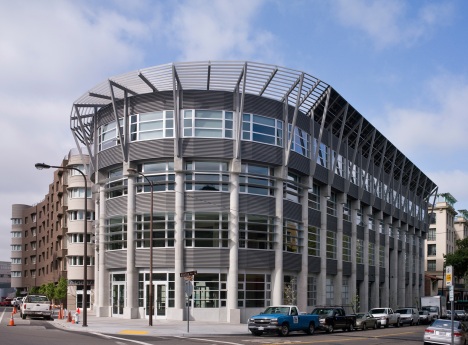
I am UPM student who also study on environment. This article is quite interesting, I am having fun to read this. Keep it on!
Hello Viola. Thanks! Environmental courses used to be very cold subjects in Malaysia. Good to see it picking up these days. I was an environmental student myself too. Well all the best to you =) Perhaps UMS and UPM can work together some day for some environmental work! You never know =)
Ya, hope so. So far UPM still not have an formal organization cope with the environmental awareness issues for the students (>.< is too bad).
However, we have a program held by my faculty (Faculty of Environmental Studies) and the Student Affair, we try to create awareness to ban the using of polystyrene in campus (just like the USM "White Coffin" program). It is still in the early stage, so we can't observe the effect yet… But, hope can make the students aware to our environment issues.
Nice talk to you. If you know any events ralated to environment, please tell me the information too…
Thank you! =)
i’m so happy that i stumble upon your site! i’m a 2d year architecture student and we were to do a presentation on active and passive climatic design and system control, and i was to do a case study of them. i’m so glad you have the information here. however, the link to the LEO and ZEO building couldn’t work, and sadly, their official website doesn’t have more information on the building itself.
hello..i’m from uitm..i have a question which is what is the green building index rating and the points for mesiniaga
you can google them
just saying hello from a student of construction technology management, UTHM johor. 🙂